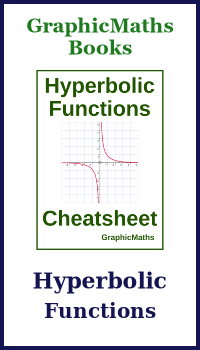Proof that e is irrational
Categories: exponentials

Euler's number, e, is an important number in mathematics that appears in many contexts.
As an example, here are two important properties of $e$. First, the following simple first-order differential equation applies to many situations from population growth to radioactive decay:

The only non-trivial solution to this equation (we will ignore the trivial solution y = 0) is the exponential function e to the power x:
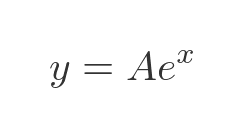
Second, e is involved in Euler's formula, which is the bedrock of the complex analysis (the study of complex numbers):

If we substitute the value π for θ we get Euler's identity:
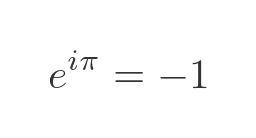
This formula puts e at the heart of mathematics. It links what are arguably the three most important constants in mathematics, pi, e and i, in a single formula.
It turns out that e is an irrational number, and in this article, we will look at Fourier's ingenious proof of that.
Fourier's proof
Joseph Fourier's proof is a proof by contradiction. We start by assuming that e is rational, meaning that, for some positive integers a and b we have:

We will prove that this leads to a contradiction, and therefore cannot be true. This is a similar approach we saw for the proof that the square root of 2 is irrational, although after this initial step, the two proofs are quite different.
This proof relies on the Maclaurin expansion of the exponential function, given by:

We can use this to find an expression for e, simply by setting x equal to 1:

Properties of factorials
Before we get into the proof, we will look at a couple of properties of factorials that will be useful later. The factorial of n, of course, is the product of n and every positive integer less than n:

There is a special rule that 0! is equal to 1.
Any factorial is divisible by any smaller factorial. For example, 7! is divisible by 4!, because the smallest four terms are identical, so they just cancel out:

So in general, if n ≥ m we can write the quotient of the factorials like this:

This is always an integer, because each term in the product is an integer. We will use this fact later.
If n < m we get a rational fraction (it is always one divided by an integer):

On with the proof
So far we have shown that if e is rational, then the following must be true (where a and b are positive integers):

We are, of course, hoping to prove that this equation cannot hold when a and b are positive integers. That will prove that e is irrational.
It will be useful to multiply both sides by b!:

Looking at the right-hand side, each term has a denominator that is a factorial, and the factorial becomes larger with each successive term. We can split the terms into two groups - those where the denominator is less than or equal to b! and those where the denominator is greater than b!. All we have done is group the terms, we haven't changed anything:

Let's write this as:
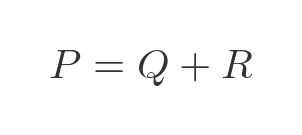
We can look at the terms one by one. P can be simplified as follows:

We have used the fact that b! is equal to b(b-1)!, then cancelled out b top and bottom. Since a is an integer and any factorial is an integer, it follows that P is an integer. As we will see, that is all we need to know about P.
Now on to Q:

Every term on the right has the form n!/m! where n ≥ m. We saw earlier that this always evaluates to an integer. This means that Q is the sum of a finite set of integers so Q must be an integer.
So we have shown that if a and b are integers, P and Q must also be integers. And if P is equal to Q plus R, then R must also be an integer.
If we can prove that R is not an integer, we have a contradiction. In that case, P cannot be an integer, so a and b cannot be both integers, so e cannot be rational.
Finalising Fourier's proof
From above, we have:

This is an infinite series, so how do we prove it is not integer? There is no obvious way to solve it, but fortunately, Fourier found a clever method to prove that whatever the result is, it cannot an integer.
First, since b is a positive integer, therefore greater than 0, we can say for certain that R > 0.
Can we find an upper bound? Let's expand the first few terms, using the factorial rule we discovered earlier for n!/m! when n < m. The first term is:

The second term is:

Fourier now uses a clever simplification. Since (b + 2) is greater than (b + 1), if we substitute (b + 1) in the denominator it will make the fraction bigger. So we can say that:
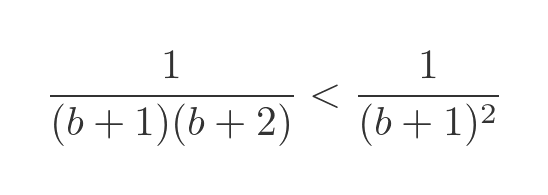
Which in turn gives us the result that:
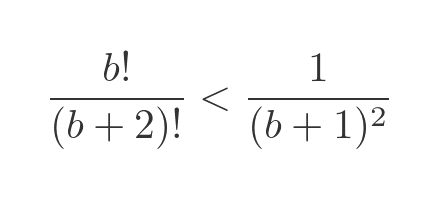
The third term is:

We can do the same thing, substituting both (b + 2) and (b + 3) with (b + 1) and applying the same logic:

If we do the same for every term, we can say that:

Notice that R is strictly less than the sum because every term except for the first is overestimated in the formula above.
Since b appears in each denominator, so the smaller b the larger the sum. We know b is a positive integer, so the largest value for the above equation would be if b was 1. In that case, the sum becomes:

This is a well-known geometric series that sums to 1. R must be less than this maximum. Since we already know R is greater than 0 we have:
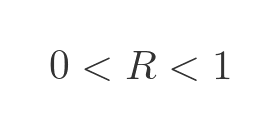
There are no integers that are greater than zero but less than one. So R cannot be an integer. As we have already shown, this means that e cannot be rational.
Related articles
Join the GraphicMaths Newsletter
Sign up using this form to receive an email when new content is added to the graphpicmaths or pythoninformer websites:

Popular tags
adder adjacency matrix alu and gate angle answers area argand diagram binary maths cardioid cartesian equation chain rule chord circle cofactor combinations complex modulus complex numbers complex polygon complex power complex root cosh cosine cosine rule countable cpu cube decagon demorgans law derivative determinant diagonal directrix dodecagon e eigenvalue eigenvector ellipse equilateral triangle erf function euclid euler eulers formula eulers identity exercises exponent exponential exterior angle first principles flip-flop focus gabriels horn galileo gamma function gaussian distribution gradient graph hendecagon heptagon heron hexagon hilbert horizontal hyperbola hyperbolic function hyperbolic functions infinity integration integration by parts integration by substitution interior angle inverse function inverse hyperbolic function inverse matrix irrational irrational number irregular polygon isomorphic graph isosceles trapezium isosceles triangle kite koch curve l system lhopitals rule limit line integral locus logarithm maclaurin series major axis matrix matrix algebra mean minor axis n choose r nand gate net newton raphson method nonagon nor gate normal normal distribution not gate octagon or gate parabola parallelogram parametric equation pentagon perimeter permutation matrix permutations pi pi function polar coordinates polynomial power probability probability distribution product rule proof pythagoras proof quadrilateral questions quotient rule radians radius rectangle regular polygon rhombus root sech segment set set-reset flip-flop simpsons rule sine sine rule sinh slope sloping lines solving equations solving triangles square square root squeeze theorem standard curves standard deviation star polygon statistics straight line graphs surface of revolution symmetry tangent tanh transformation transformations translation trapezium triangle turtle graphics uncountable variance vertical volume volume of revolution xnor gate xor gate
